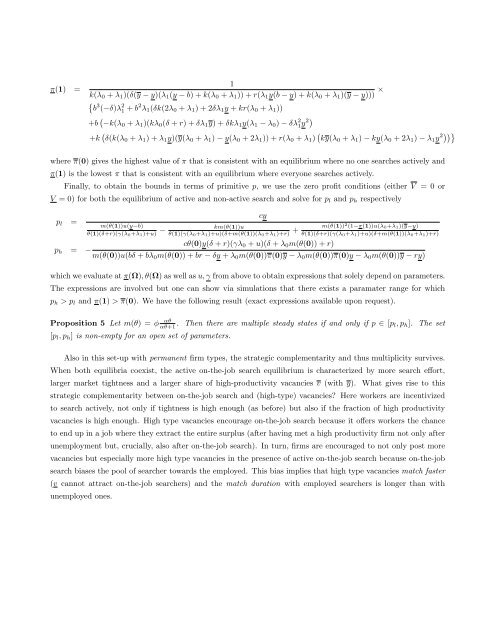Unemployment cycles
WP201526
WP201526
You also want an ePaper? Increase the reach of your titles
YUMPU automatically turns print PDFs into web optimized ePapers that Google loves.
π(1) =<br />
1<br />
k(λ 0 + λ 1 )(δ(y − y)(λ 1 (y − b) + k(λ 0 + λ 1 )) + r(λ 1 y(b − y) + k(λ 0 + λ 1 )(y − y))) ×<br />
{<br />
b 3 (−δ)λ 2 1 + b 2 λ 1 (δk(2λ 0 + λ 1 ) + 2δλ 1 y + kr(λ 0 + λ 1 ))<br />
+b ( −k(λ 0 + λ 1 )(kλ 0 (δ + r) + δλ 1 y) + δkλ 1 y(λ 1 − λ 0 ) − δλ 2 1y 2)<br />
+k ( δ(k(λ 0 + λ 1 ) + λ 1 y)(y(λ 0 + λ 1 ) − y(λ 0 + 2λ 1 )) + r(λ 0 + λ 1 ) ( ky(λ 0 + λ 1 ) − ky(λ 0 + 2λ 1 ) − λ 1 y 2))}<br />
where π(0) gives the highest value of π that is consistent with an equilibrium where no one searches actively and<br />
π(1) is the lowest π that is consistent with an equilibrium where everyone searches actively.<br />
Finally, to obtain the bounds in terms of primitive p, we use the zero profit conditions (either V = 0 or<br />
V = 0) for both the equilibrium of active and non-active search and solve for p l and p h respectively<br />
p l =<br />
m(θ(1))u(y−b)<br />
θ(1)(δ+r)(γ(λ 0+λ 1)+u) −<br />
cy<br />
km(θ(1))u<br />
θ(1)(γ(λ +<br />
0+λ 1)+u)(δ+m(θ(1))(λ 0+λ 1)+r)<br />
m(θ(1)) 2 (1−π(1))u(λ 0+λ 1)(y−y)<br />
θ(1)(δ+r)(γ(λ 0+λ 1)+u)(δ+m(θ(1))(λ 0+λ 1)+r)<br />
cθ(0)y(δ + r)(γλ 0 + u)(δ + λ 0 m(θ(0)) + r)<br />
p h = −<br />
m(θ(0))u(bδ + bλ 0 m(θ(0)) + br − δy + λ 0 m(θ(0))π(0)y − λ 0 m(θ(0))π(0)y − λ 0 m(θ(0))y − ry)<br />
which we evaluate at π(Ω), θ(Ω) as well as u, γ from above to obtain expressions that solely depend on parameters.<br />
The expressions are involved but one can show via simulations that there exists a paramater range for which<br />
p h > p l and π(1) > π(0). We have the following result (exact expressions available upon request).<br />
Proposition 5 Let m(θ) = φ αθ<br />
αθ+1 . Then there are multiple steady states if and only if p ∈ [p l, p h ]. The set<br />
[p l , p h ] is non-empty for an open set of parameters.<br />
Also in this set-up with permanent firm types, the strategic complementarity and thus multiplicity survives.<br />
When both equilibria coexist, the active on-the-job search equilibrium is characterized by more search effort,<br />
larger market tightness and a larger share of high-productivity vacancies v (with y). What gives rise to this<br />
strategic complementarity between on-the-job search and (high-type) vacancies? Here workers are incentivized<br />
to search actively, not only if tightness is high enough (as before) but also if the fraction of high productivity<br />
vacancies is high enough. High type vacancies encourage on-the-job search because it offers workers the chance<br />
to end up in a job where they extract the entire surplus (after having met a high productivity firm not only after<br />
unemployment but, crucially, also after on-the-job search). In turn, firms are encouraged to not only post more<br />
vacancies but especially more high type vacancies in the presence of active on-the-job search because on-the-job<br />
search biases the pool of searcher towards the employed. This bias implies that high type vacancies match faster<br />
(v cannot attract on-the-job searchers) and the match duration with employed searchers is longer than with<br />
unemployed ones.


